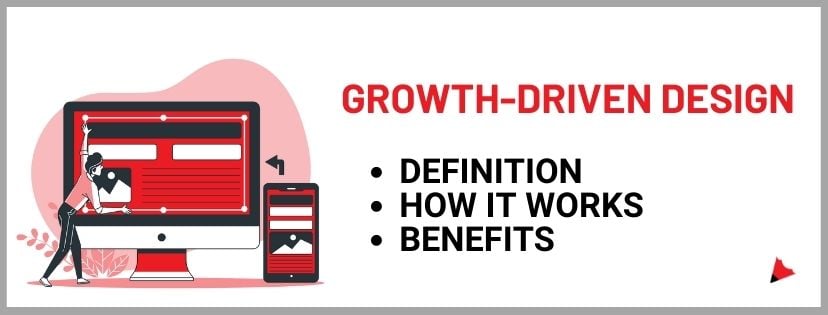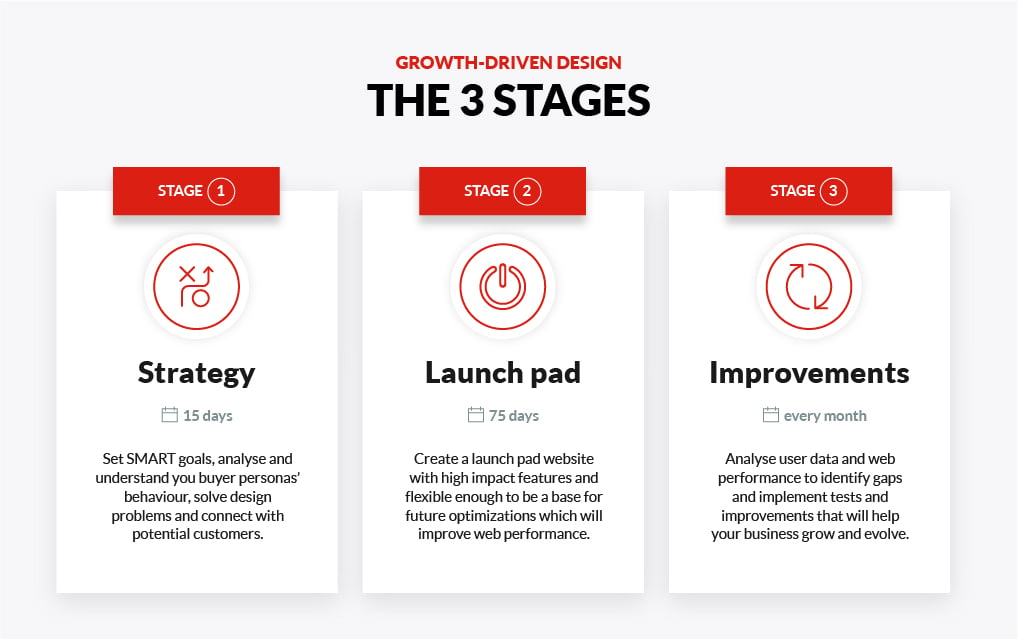
Web design has changed dramatically over the past couple of decades.
New technologies and innovations are constantly paving the way for new kinds of websites and features.
However, the process for designing these websites has been relatively untouched.
It may not have been the best approach, but at the end of the day, it worked.
Sure, it created many headaches and problems along the way, but a website still got built and people put up with it because there really wasn’t a better way..
..until Growth-Driven Design (GDD) started to gain momentum.
What is Growth-Driven Design?
It is an approach to website design and maintenance that succeeds in minimizing the risks of traditional web design.
Instead of launching a full-scale website entirely on assumption, GDD focuses on making data-backed decisions and continuous improvement.
This retainer-based web design methodology spreads out costs and enhances the flexibility of operations, as opposed to waiting months to finalize every minute detail of a website.
Growth-Driven Design is an investment that produces reliable month-over-month growth.
Your website becomes stronger as you continue to measure, iterate and act.
Rather than undertaking a site redesign every two to three years with stale content that no longer aligns with the organization’s priorities, GDD succeeds by making informed performance improvements to your site based on testing, continuous learning, and research that’s derived from visitor behaviors on your site.
Traditional web design processes (which may take place just once every few years, and require lengthy specification and build times) are often not reactive enough to achieve this level of dynamism.
Equally, such projects can be expensive, requiring large up-front budgets for a site that may slip out of scope by the go-live date.
As opposed to traditional web design, GDD allows faster launch timelines and month-on-month agility to make your website an ever-evolving business asset.
.png?width=1200&name=the%20modern%20marketing%20skillset%20framework%20(7).png)
How does Growth-Driven Design Work?
The Growth-Driven Website Design methodology has three major stages
- The Strategy Blueprint phase
- The Launchpad phase
- The Continuous Improvement phase

The above infographic (Source) gives an overview of the three stages of GDD.
1) The Strategy Phase
Any successful website starts with a Growth Strategy.
Its objective is to solve web design problems keeping the target audience in mind.
That's why the first step of Growth-Driven Design is to devise the buyer personas that establish a basis for the implementation of future strategies.
The second step is to establish SMART objectives based on historical results obtained and the needs of the marketing and sales teams.
With clear and measurable objectives, it’s possible to propose a design focused on obtaining results.
To set these objectives, you’ll need to perform a website audit in quantitative and qualitative terms to improve touchpoints with visitors and their conversion rate.
The third step in this strategic approach is to develop a wishlist organized into ideas, such as a viable implementation plan with which to implement initial actions that are adaptable and can be adjusted as time passes and new data obtained is collected.
2) The Launchpad Phase
Once the growth strategy to be followed is established, you need to start designing and developing a "launchpad" website that's flexible and adaptable, serving as a starting point to implement improvements once enough data has been collected from users.
In the traditional web design system, the launch is the endpoint of the project.
In the case of GDD, it is the starting point with essential elements based on the objectives set in the Growth phase.
3) The Continuous Improvement Phase
Once the launchpad is live, you'll begin to collect on user behavior.
Their interaction with the website pages will give you insights into their interests and browsing behavior.
These insights will help you make changes to the website to improve performance.

Benefits of Growth-Driven Design
There are several benefits that come with GDD.
The most obvious ones are listed below:
Continuous Improvement
The biggest benefit of GDD is the opportunity to continuously improve your website.
This model allows businesses to spend less time and money on updating and refining the features of their website since the website isn’t set in stone and is constantly evolving.
They’re constantly adapting to what the user wants, resulting in better performance.
Shared User Insight
User insights can be shared with sales and marketing teams to make real-time decisions together, allowing for a much more holistic workflow.
Minimized Risk
When you work with a traditional website design, you carry a lot of risk with the final product.
There are hefty costs to the design itself, substantial time requirements, and complicated day-to-day procedures.
In GDD, you have the ability to be dynamic and be free of the rigidities that come with the traditional web design model.







